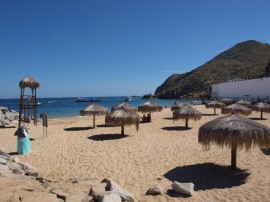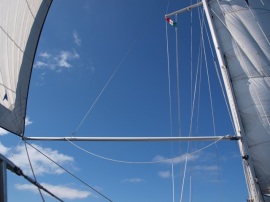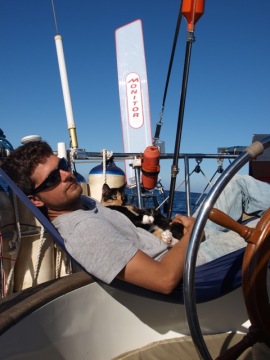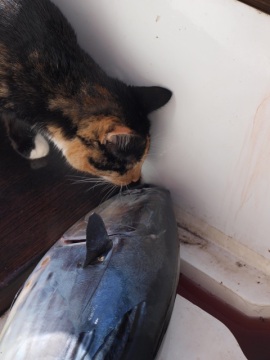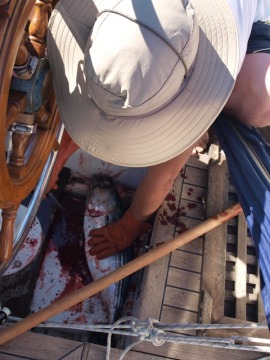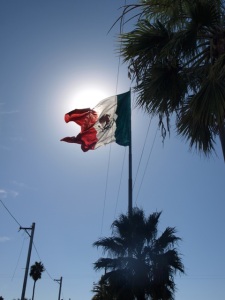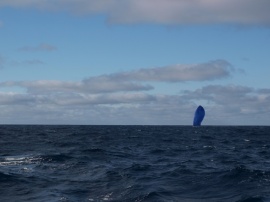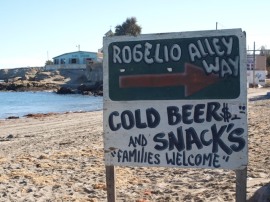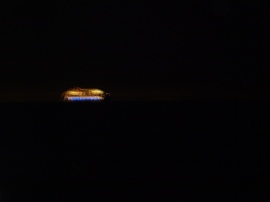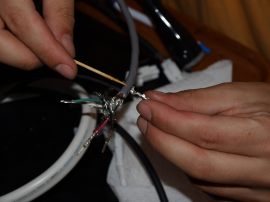Velella's Drift
An account of Velella's voyage from Seattle to New York via Panama, 2009-2011Archive for LA to Cabo
Happy Thanksgiving
22 53.65′ N
109 53.16’W
We put on Christmas music yesterday and I was reminded of being snowed in to Prescott’s apartment in Seattle a couple years ago. I held that chilly, cozy thought in my mind as I savored a tart slice of grapefruit in the blinding sun. It’s hard to believe that today is Thanksgiving, because being from “up North”, I associate this day with piles of snow and hot cider and pumpkin bread bounty. This year though, our Thanksgiving will be celebrated with a swim and snorkel in the 75-degree “pool,” fresh guacamole, and bright yellow cans of Pacifico Clara. There is no sign of Thanksgiving in the sweeping blue bay at Cabo San Lucas, but I have a long list of things I am thankful for.
Numerous times on the way down the coast, I decided to become the voluntary spokeswoman for several pieces of gear we have on Velella. I even tried to write a couple odes (I’m not kidding.) It’s no secret that cruising is seriously hard work–so our gear choices have become hugely important to me on a daily and hourly basis. Let me give you an example.
Because we’re downwind sailing almost all of the time in relatively light air, our foresail tends to collapse and snap full when we’re rolling over the swell. It’s hard on the rig and irritating, and most often requires us to douse the sail altogether and sail on just the main (a slow way to go). So, I am extremely thankful for our brand new whisker pole, compliments of Forespar, which is rigged on a sliding track on the front of the mast. The pole telescopes and holds the foot of the foresail out on the opposite side of the main (to windward), allowing the sail to fill with air unobstructed by the main and steadying it from collapse. We spent 48 hours recently running wing on wing with the whisker pole making 6.5 knots instead of 4–a HUGE improvement in speed for us. The whisker pole turned what could have been a passage of two nights and three days into only one and a half days. Which means more time lounging around at anchor, reading and snorkeling in the sun–and that’s the point of all this, right?We also upgraded Velella with a SSB transiver and Pactor Modem, a combination of radio equipment which allows us to receive daily weather forecast files on our computer and connect with huge nets of sailors headed in our same direction. Every day, we listen to Don Anderson from Santa Barbara give detailed voice forecasts for our specific locations–it’s like having a professional weather router for free. And, the modem allows us to send and receive email from home. On a journey filled with empty sea and time alone, the ability to connect over long distances with other sailors and with our family is a crucial component of our morale.
Perhaps the biggest boon has been the Monitor self-steering wind vane. I can’t say enough about this ingenious framework of stainless steel mounted quietly on our stern. Not only does it draw zero energy, deriving all of its power from the wind and leverage from mechanical gears, it steers the boat flawlessly and efficiently. The Monitor has taught us to be better sailors, because in order for it to work, the sails need to be perfectly balanced. It’s been the best teacher of the fine art of sail trim I’ve ever had. It steers the boat 98% of the time–freeing the former helmsman up to view dolphins from the bow, go below to make a quick sandwich, or curl up under the dodger with a book at night. It is such an integral part of our lives that we even gave it a name (a common thing for cruisers to do actually). In our logbook when we notate the running position, barometric reading, conditions, etc., under “At the Helm” we now put “SG” more often than not. Samwise Gamgee at the helm. Prescott named it Sam after the Lord of the Rings character–when I asked him why that name, he replied, “because when Frodo was too weak to make it up the mountain with the Ring, Sam was the one who carried him.”Oh, and the list goes on. Our hot black sun shower, shady sun awning, powerful array of solar panels, etc. etc. They all come together in a fantastic symphony working together to make the trip safe, comfortable, and so much fun. So I am extremely thankful this Thanksgiving that we have gear that acts as a silent crew, helping us with the heavy lifting of such an undertaking.
Hola, Mexico!
We entered Mexican waters over a week ago, but it wasn’t until yesterday that we actually set foot on shore in Bahia de Tortugas for our first $1 cervezas on the beach.* Offshore, there was little to distinguish the coast from that of southern California, although night watches have gotten progressively warmer (or perhaps that’s only psychological, it’s hard to tell.) Groups of islands that look remarkably similar to California’s Channel Islands have appeared every hundred miles or so; the Coronados, Islas de Todos Santos, and Isla Cedros and surrounding islets. The arid coastline has been marked by deep arroyos, scrubby sage-colored vegetation, and pods of dolphins and spouting whales. Pacific sunsets each night are spectacular, and sunrises even more so after twelve hours under the stars. The most marked difference in Mexican water so far has been the red, white, and green courtesy flag flying from our starboard spreader—each time I trim the sails I’m reminded that we’re guests here.
After over a week of lonely voyaging (with one stop in a desolate anchorage where we didn’t go ashore), we pulled in yesterday morning to Bahia de Tortugas, or Turtle Bay, a favorite all-weather port for cruisers making passage down the Baja coast. For days, I had looked forward to arriving at the small village our guidebook reported as having a café, hospital, grocery store, hotel, etc. We could top off our diminishing water supply, re-provision, send emails and photos to family from the internet café, and do laundry—the ultimate luxury! Pulling in to the bay, though, I was dubious that we’d find any of that, as the village appeared to be no more than a few deserted shacks on shore. But there was a large sign painted on a concrete seawall in black lettering that said “Bienvenidos a Bahia Tortugas.” We must be in the right place.
After a fabulously revitalizing sun-shower in the cockpit and a much-deserved three-hour nap, we decided to get the dinghy down and row to shore on a reconnaissance mission. On our way towards shore, we passed a panga moored some way off the beach that was filled to the brim with pelicans — so far, the only sign of life in Bahia de Tortugas . We were pleased to find a floating dinghy dock extending out from the pier though, a nice alternative to surfing the dinghy up to the beach. We tied up next to a handful of other cruisers’ tenders, climbed the suspect staircase up to the pier, and met Pedro and Enrique, the dock attendants.
Though they spoke little English and we little Espanol, we determined that they not only had purified water, they would deliver it to our anchored boat and fill our tanks for less than $15 (the alternative would be a tricky “med-moor” to the pier with heavy surge, no thank you). They showed us the laundry lady’s home next to the beach—she does all your laundry and returns it to you folded. Then Pedro walked us all the way to the mercado grande, and on the way back showed us where showers and the wifi cafés were.
It amazes me that in a sleepy town that’s half-finished or torn-town structures are all covered in windblown desert dust, and where there appears to be no more than a couple dozen people living, there are not one but TWO free wifi cafes.
We were quickly introduced to the circle of gringo cruisers sitting along the beach with cervezas, and we made friends with several couples instantly. After all, it’s a very small community, and we have quite a bit in common. The cruising community is a strong one, in part because it’s small, and in large part due to the lack of constant access to the internet. Going cruising is like stepping back in time—no longer can you look up the NOAA weather forecast online, or the phone number or directions to the nearest repair shop, or where to get a good hot meal in a given city. Cruisers keep a wealth of information alive for each other by sharing bits of information constantly on shore and over the radios. It would be tiring if you had to find your way around a new town every other day, but as soon as you drop the hook, a chat with your first cruising neighbor reveals not only where the port captain and grocery store is, but also where to find fresh bread baked daily, or where locals will trade you five live lobster for two of your beers.
I’m on shore today to buy some yeast so I can bake bread for one of our sailing neighbors, who is lent me her sewing machine so I could fix a tear in our mainsail. We all check in daily to several cruising nets on the SSB radio, to hear weather forecasts tailored specifically to those of us “on the net;” to take down each other’s passage plans and positions, to relay messages between friends over thousands of miles of ocean.
Our newfound cruising community gives us a great sense of security. Until now, we’ve been alone and offshore, and seeing a ship’s lights on the horizon at night (or even more unnerving, an unlit ship on the radar) sends chills down my spine sometimes. But since we’ve arrived at Bahia de Tortugas and met more cruisers, we look forward to checking in with them daily on the nets and swapping red peppers for beer or gum for fresh shrimp. Ironically, we’re strengthening our human community by venturing farther off the grid than ever before.
Until the next check-in, this is Velella, WDF4539, clear and on the side!
( *We actually did spend four and a half hours on Mexican soil a week ago clearing in to Ensenada, but I maintain that you haven’t truly arrived in Mexico until you’re having a cerveza on the beach! )
Daylight Savings
31 10.23’N, 117 06.38’W
“Dark as night” gets to deeper levels when you’re 50 miles offshore at 3am. The absence of the moon makes the blackness complete, since the stars shed no light, but merely leave a pointillist reminder of what light was like in the sky.
I awoke for watch at 2am this morning; Prescott had been on since 8pm. We’re doing 6-hour night watches this time around, because 4 on 4 off is just too exhausting on too little sleep for us. If the weather is good, 6 hours passes painlessly, even in when it’s pitch black. Still, you have to count the hours.
We wake each other up for watch with a hot cup of black tea. Once I get settled in to the cockpit (position and course understood, sails and autopilot tuned how I want them), I clip in and curl up under the dodger with several pillows, a fleece blanket, and my warm mug. For the first hour, I let my mind go totally blank for as long as I can. I don’t know why I do this-probably in part because I’m just waking up, and in part because I’m trying to save all my thoughts and activities for later in the watch when I’m bored. Surprisingly, my first blank hour sails by quickly.
By the second hour, my boiling hot tea is finally cool enough for me to drink. So I turn on my iPod and listen to music while I enjoy it. For an hour. The third hour is when I start writing in my head. I consider several possible stories and detail them at length in my mind. The fourth hour is when I get out my computer and actually start typing. By the fifth hour I’m hungry, so I consider at length what kind of breakfast I should make when Prescott gets up. This decision takes into account the sea state, the temperature, what’s on top of the fridge, and how strong my stomach is feeling.
Just when I’ve decided on pancakes and coffee and start feeling sick because I haven’t seen the horizon for so long, the darkness begins to lift, just a little bit, in the East. Like a heavy blanket it’s pushed up by a light grey arc, which becomes purple, then pink, then orange, then glorious light blue as the sun lifts swiftly over the horizon and thaws my fingers. Nessie often wakes up in time for the sunrise and watches it with me from the cockpit. As I write this, a lone tern has found Velella and is circling and dive-bombing us-an activity which Nessie finds endlessly amusing.
We are currently making way southward toward Turtle Bay, about halfway down the Baja peninsula and clipping along at close to 7 knots. Since we’ve left Los Angeles, the weather has been warm and welcoming. Yesterday, we spent less than 24 hours on a brief stop in Ensenada to clear in to Mexico-an onerous task which took no less than five of those hours, after which we slept for twelve.
I’ve read and heard that Pacific Baja is like the husk surrounding the fruit of the Sea of Cortez. But with weather like we’ve been having offshore, and the hot southern sun rising over my shoulder right now, I rather like the husk! At this rate, we may be in Turtle bay by the end of the day tomorrow-which means only one more yawning night before we can curl our toes on the beach and relax. Meanwhile, you can follow our live track (see “Where’s Velella Now?” in the Pages column to the right).
Sailors, sailors, sailors
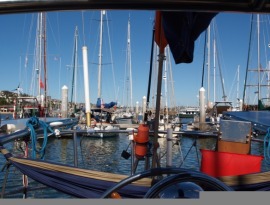 San Diego is great, and I’m glad we get to spend some time here. After sailing all day Sunday and doing a night watch on Halloween (spooky!) we pulled into port here Monday evening. The sun was setting and the skyline was all a-glimmer. The skyscrapers of this healthy-sized city stand watch over the waterfront, and for a moment I felt like we were heading back into Seattle. A blast of desert breeze reminded me that we were still in southern California, and that things were only getting warmer.
San Diego is great, and I’m glad we get to spend some time here. After sailing all day Sunday and doing a night watch on Halloween (spooky!) we pulled into port here Monday evening. The sun was setting and the skyline was all a-glimmer. The skyscrapers of this healthy-sized city stand watch over the waterfront, and for a moment I felt like we were heading back into Seattle. A blast of desert breeze reminded me that we were still in southern California, and that things were only getting warmer.
In addition to being markedly warmer, San Diego as a whole seems more hospitable than Los Angeles. Boating is king in San Diego bay and the waterfront community is built to cater to us cruisers, a far cry from the terrible customer service in Marina Del Rey. And although the water is still the same LA shade of murky green, there is at least evidence of life. Sea anemones cling to the side of the docks, reminding us of how disgusting our former home was.
As we puttered up to our guest dock, we noticed a small motor boat coasting parallel to us. One of the crew reached into the water… and a dolphin broke the surface right under his hand. No joke! Sea World is only a couple miles away, and perhaps this dolphin is a part-time employee. Meg watched enviously as the dolphin rolled over for a stomach scratch. “Hey, I want to pet a dolphin!” I promised Meghan I’d find her a dolphin to pet before the end of our trip.
We’re not in any particular hurry to head down to our Mexican port of check-in, Ensenada. The weather seems to be holding at less than ten knots of wind for the next week, and the ocean swell is diminishing day by day. At 10.50 a night our San Diego slip is a bargain, especially when compared to the $105 a night fee for the yacht club next door. The next leg of our trip is the desolate Baja coast, which I’m not looking forward to. It’s a rocky desert coast with bad anchorages, dusty scenery, and expensive provisions. Our guidebook compares Baja to a fruit, describing the Pacific Coast as the “dry husk that protects the succulent Sea of Cortez”. We’ve been told to make haste down Baja and get to the good stuff.
To get the information we needed we spoke to a half dozen cruisers. Or rather, they spoke to us. Conversations are rare in the cruising world. What’s more common are sailors talking over one another or, if you’re like us, getting talked “at” until you come up with your excuse to make an exit. As I told Meghan yesterday, my least favorite thing about sailing is other sailors.
There are three main categories of sailors. The first is the Long-Winded Cruiser. These are the guys waiting on the dock as you sail into port. They don’t help with the lines, but immediately ask their gateway question: “Where ya’ comin’ from?” It doesn’t matter what you answer. The Long-Winded Cruiser launches into his prepared sea shanty about the weather, his recent travels, or whatever sailing-related topic is on his mind. After half an hour of nodding politely, you finally excuse yourself to finish tying up the boat. Strap a Long-Winded Cruiser to your mast and these blowhards will keep your sails full.
Type two is the Jimmy Buffet. The Jimmy Buffet doesn’t exist north of 38 degrees. He tends to congregate around the equator, and becoming increasingly prevalent as you head south. He’s easy to recognize: Look for the mullet and the t-shirt with booze-related slogan (‘its happy hour somewhere’). His boat is a Frankenstein’s Monster stitched together out of balsa wood, stove pipe and frayed dockline. The Jimmy Buffet can be humorous or downright sketchy. Last night as Meg and I were going to sleep, we heard a knock on the hull. I went up top to investigate, only to find a drunken Jimmy Buffet. staggering on the dock. His slur was thick, but eventually I realized that he’d mistaken Velella the wrong boat and was climbing aboard! I informed him of his error, he mumbled an apology, and we locked our doors.
The worst kind to sail with is type three, The Captain. The Captain doesn’t have his captain’s license, but knows how best to do everything, all the time. He sails his boat like a warship, and often has a naval background. Even when sailing your boat, there are only two ways of doing things: The Captain’s way and the wrong way. The Captain loves a good argument, so it’s best to suppress what you’re really thinking. A better strategy is just to nod politely… and never invite him on to your boat!
There are so many sailors, I expected more variety. Where are the odd ducks from the Pacific Northwest? Where are all the good folk from Minnesota? I’m excited for people to start visiting us. My parents are coming in December and Peter, my friend from high school. After that Meghan’s parents will join us and her friend Tessa. Following two years of conversations about the boat, I hunger for any stimulus not sailing-related. What I wouldn’t give to have a conversation about philosophy, cars, or politics. Hell, I’ll even talk about football.
So if you’re reading this, come on down! You can bring us word from the outside world and in exchange we’ll teach you how to sail, and give you a glimpse into this unique lifestyle. It’s like nothing else on the planet, and I guarantee you’ll enjoy it. And if I yammer on, you’ll have to forgive me. I am, after all, a sailor.
ADDENDUM: As I reread this, I realize that Velella is flanked on either side by boats from Canada. Their presence requires me to add a fourth category: The Canadian. They are polite, clean, and make liberal use of the word “Eh?”
Upgrades to Velella’sDrift
Just wanted to call your attention to a couple of new things in Pages and Links:
First, we’ve added a Forespar link because they are now another official sponsor of our trip! They contributed some absolutely fabulous gear that I’ll be writing about soon.
The Itinerary Page is now updated with a pretty little graphic of roughly where we’ll be when.
There’s a new “Where’s Velella Now?” page that links to our GoogleMaps breadcrumb trail, so you can see where we’ve been for the past week.
And, there’s a new Outfitting Image Gallery if you’re curious to see what we’ve been doing all year in LA.
Forced into the moment
Yesterday, I chiseled off the last of dozens of teak plugs that I replaced on Velella’s decks. I spent days sanding, routing out old caulking, and smoothing in new shiny black lines. Months, actually. The plugs were the last in a long line of deck-related projects, and now she’s snug and dry and ready for sea.
We’re moored right next to the seawall in Marina del Rey’s D Basin, so we often have passers-by calling over the fence into our cockpit. I looked up from sanding when a guy said “So, when’r you leavin?” I said “Saturday, maybe Sunday.” And he smiled wide and said “Congratulations.”
People usually say “good luck” or “have fun” or “fair winds” when they hear about our plans. But this gentleman clearly had done this before, because instead he was congratulating me on how far we had already come.
I get close to tears when I realize it’s finally, finally here. (Who am I kidding? I bawl my eyes out.) This day came so suddenly and quietly after months and years of work–the list just evaporated and all that’s left is to turn in our keys. Our good friends Anna and Brad flew down from Seattle and drove away with our car, and just like that, we were back in cruising mode. On foot, slowed down, forced to deal with the moment rather than the future.
Since I had been going 60 miles an hour since I woke up yesterday (this whole month really), I was jittery when we went to bed. In order to help me fall asleep, I asked Prescott to tell me a story, because he’s really good at that. He asked if a story about the Gold Rush would be okay. I looked at him warily. He began: “Once upon a time, there was a prospector looking for gold. But he wasn’t rushing.”
I asked him to stop the story right there, because that was perfect. As I fell asleep, I congratulated us on arriving to a place where we are no longer rushing, and no longer looking forward to what’s next.
The Magic of HF Radio
I remember in middle school the annual trips to Fry’s, staring in wonder down the aisles full of technology. But that was always for computer games or a faster computer on which to play them: Purchases within societal norms. I wasn’t the hardcore techie. I didn’t bring food into the store, wear a Hawaiian shirt over my beer gut, or dig with sticky hands through the bargain bin in search of cheap diodes, circuit boards, or ferrite clips.
But working on our SSB, I came pretty darn close. I realized, as I was trying to explain what an SWR meter is, how bad I sounded. “I need to check the impedance in my HAM radio to see how many ferrite clips I need.” The clerk had no idea what I was talking about.
I say HAM radio because most people have at least a basic understanding of what HAM radio is. Not true for SSB, although they are essentially the same. Both HAM and SSB operate on high frequency radio waves, which give them their signature long range. While HAM stations and SSB transceivers pick up the same frequencies, certain channels are “locked” for transmitting. To gain access to these channels, the operator is required to get a HAM license from the FCC. It’s more effort than is necessary for us, and hopefully keeps us out of the uber-nerd category.
The idea of high frequency radio on our boat blows my mind. We can communicate with people 500, 1000, 2000 miles away, using the same frequencies as my childhood walkie-talkies. With an expanded range we have access to a varied and bizarre list of non-commercial stations. There’s a community college in Texas that broadcasts the BBC, and a naval base in Puerto Rico that carries NFL games. Though we bought it for weather information, it will also be our major source of entertainment. Our options are limited though, and will change as we head south.
By far the coolest thing about our radio is the Pactor modem, a gift from Meghan’s dad. Similar to the modems of circa 1994, this device transmits data information through sound. We hook up our laptop to write our emails which are compressed and sent to the Pactor. The Pactor converts the data into a series of chirps and whistles, and then our antenna spits them out across the ocean. They are picked up by one of fourteen stations around the world, converted back into data, and sent through the internet.
The data transfer rate is about 1 kilobyte a minute. This likely means nothing to you, until you consider that a good cable internet connection is 1,000 kilobytes per SECOND. In other words, 60,000x faster than our connection. If you remember 15 years back to using your dial-up modem, it still operated 900x faster than our SSB.
For this I’m profoundly glad. While it’s a great consolation to receive emails from friends and family, part of the rationale behind our journey is to unplug. I don’t want to look at the internet, or any screen, for the next 9 months. The SSB gives us enough contact for comfort, while allowing communication to remain precious. In the early days of the internet, I had to wait patiently for each email to download from the internet. The SSB harkens back to the early days of the internet, when email was transitioning from postal mail to the instant messages of today. I’m already anticipating our nightly ritual of booting up the SSB, turning on the laptop, and gathering around to see what word we get from friends and family.
All we can hope for are one or two paragraph emails. We’ll get some basic weather information, but surfing the internet is out of the question. We can LOL from the middle of the Caribbean, but without the trappings of modern technology. Which, in my mind, is the magic of HF radio.
Things that go bump in the night
 Our to-do list is dwindling. It’s hard for me not to find other things to do to fill the holes… but if I did that we’d never leave. So tonight, we’re headed to Universal Studios Halloween Haunted House to scare the crap out of ourselves. You know, for fun. I hear the production value is incredibly high.
Our to-do list is dwindling. It’s hard for me not to find other things to do to fill the holes… but if I did that we’d never leave. So tonight, we’re headed to Universal Studios Halloween Haunted House to scare the crap out of ourselves. You know, for fun. I hear the production value is incredibly high.
Our haunted evening will have one of two effects on my mental preparedness for our sailing trip: 1. It will really put me on edge, and make me even more jumpy as we get underway, or 2. It will scare me SO much that everything that follows will seem not so scary really. I mean, my first few hours back on night watches will give me goosebumps, but they’ll be a whole lot less scary than if I looked up and saw a severed head hanging from the spreaders or a goopy, toothy sea monster rising up behind me to clobber Velella.
Shoot. As I write this I realize I didn’t account for my imagination.
My imagination, after all, is what makes me sometimes go “tharn.” A term we often use around the boat borrowed from Richard Adams’ Watership Down, tharn is that “state of staring, glazed paralysis that comes over terrified or exhausted rabbits, so that they sit and watch their enemies–weasels or humans–approach to take their lives.” My openly stated goal is never to go tharn. When I do, Prescott has to coax me out of it–so he actively works to ensure that I do not go tharn.
In my defense, my anxieties have matured from just things that go bump in the night. I no longer fear an accidental gybe, or Prescott falling overboard while I’m asleep, or rats running up our docklines, because we know what to do to control those situations and minimize real risk. We’ve even gotten a good handle on the capricious nature of weather (thanks in large part to our seriously upgraded onboard weather forecasting equipment and know-how). I’m confident that we can keep ourselves out of trouble.
What remains to make me tharn is fear of crippling seasickness, and not being fluent in Spanish, and (god forbid) being attacked at anchor. Seasickness, I’m sure, I will endure and survive. Spanish, I’m sure, I will learn on our long night watches on the run down Baja (thanks, Rosetta Stone). Attackers, I must keep reminding myself, always make news, and the real statistics do protect us. And we have protection in the proximity of other cruisers (particularly those whose boats are more tricked-out with stuff to steal than ours!). It’s hard for me not to consider Velella the most beautiful vessel in the world, but Prescott keeps reminding me that she’s really not the most attractive thing in an anchorage for thieves. Either way, I’m sleeping with an air horn and pepper spray by my berth, because they help me sleep more soundly.
And although I’m mostly rational and thorough about possible problems, I would be a foolish sailor if I didn’t ascribe to a certain amount of superstition. Above the nav station hangs a wooden frog figurine given to me by my aunt and uncle (because in Japanese, the word frog and the word journey “kaeru” are the same, so you give anyone you love going on a journey a frog to ensure they return safely.) We wear carved Maori amulets signifying “safe passage over water” around our necks (a gift from Prescott’s parents), and knotted red strings around our wrists, an age-old charm for favorable winds.
Finally, on Tuesday evening, the ASA staff and friends will gather at Velella for a sending-off happy hour. Of course, Neptune will be in attendance, and will be served copious amounts of good wine first. And then a few days later, we’ll depart. But not on a Friday.
American Sailing
As many of you are already aware, I spent the last nine months working for the American Sailing Association as their social media writer. During that time, I had the opportunity to go on some very cool sailing trips to the Bahamas and to Croatia to write about the experience. Well, as it turned out, they liked my narrative writing so much that when I gave my notice this fall they asked if I would continue to write for them over the course of our sailing trip.
At first, I hesitated. I told them I’d worked very hard to be free of commitment, and didn’t want to feel “indentured” to the ASA. But they said they wouldn’t ask me to do anything I don’t already do–i.e. anything outside of the writing I already post here on this blog. So, with the American Sailing Association standing there wanting to basically buy up pieces of velellasdrift, how could I refuse?!
So, the ASA will be sponsoring our trip now, and I will be sending roughly one blog per week back to the their blog site (http://www.asa.com/social_media). They have hired a new social media coordinator to work from the office, but our story will be featured as an ongoing “sailing lifestyle” narrative. In addition, they are seeking external sponsors for our trip from the maritime industry–in fact I just spoke with one today who is looking at sending some gear and coming on board as an official sponsor. So don’t be surprised if you see a burgee flying from our spreaders with some major brand logo on there. Either way, you’ll be seeing these hats a lot probably : )
Because I am truly thankful for their honest support of the “sailing lifestyle.” Only in America can you quit everything to go sailing, and make money while doing it! T-minus 10 DAYS!
